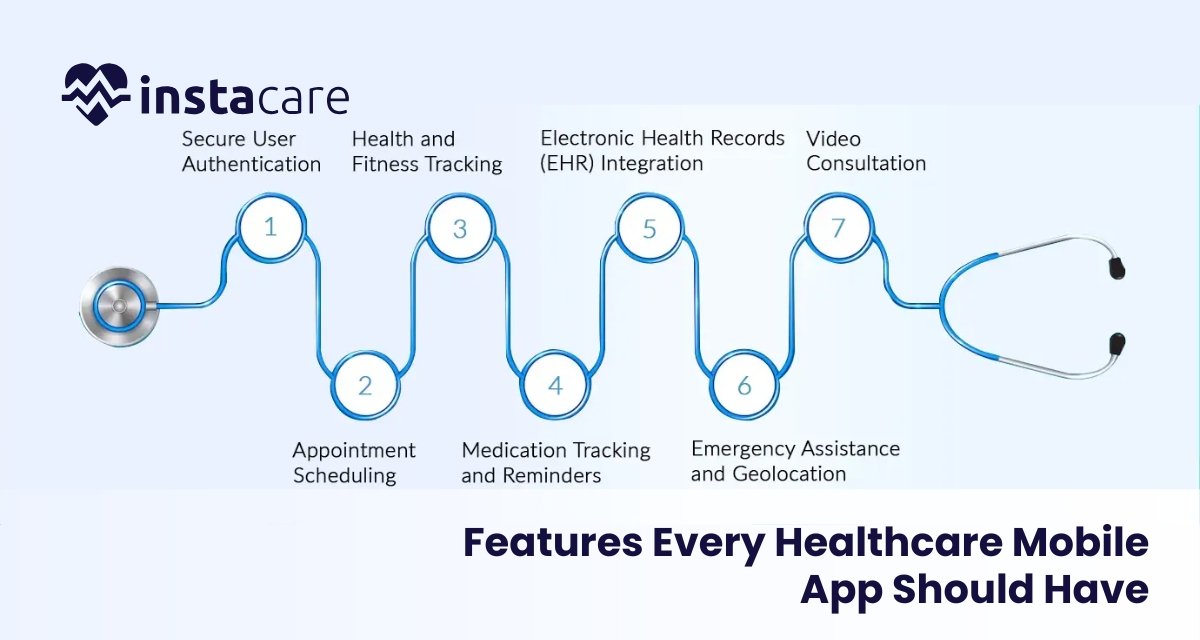Last updated on Thursday, 27, November, 2025
Table of Contents
5 Features Every Healthcare Mobile App Should Have
Mobile applications no doubt have become popular in the healthcare sector as a must have tool today. They contribute to better communication, better patient satisfaction as well as reduce many elements of manageability for patients and caregivers. The use of Health app has risen to the extent that developers must be developing features that will suit the various requirements. Here, we will discuss five critical features that every healthcare mobile app must have to be effective, usable, and satisfying for the patient.
1- User-Friendly Interface
Importance of Usability
This is therefore very important when it comes to the design of mobile applications in the health sector a user-friendly interface. This is because, patient will need to be targeted across the board young, old, technologically advanced, or not. A well-designed interface can really enhance user engagement and satisfaction, which will ultimately translate to more usage and improved health outcomes.
Key Elements of a User-Friendly Interface
Intuitive navigation: the application should ideally offer a simple layout that highlights common features such as appointment scheduling, medical records, and chat functions. Clear menus, in addition to labeled icons, can facilitate quick navigation.
- Accessibility Options: A health application should include functionalities that allow for accessibility by any person, whether disabled or otherwise. It should include voice commands, large texts, and other high-contrast color schemes.
- Onboarding Process: A proper onboarding process is necessary for new users. A tutorial or guide for a short period of time will make users understand the app functionalities, so they can easily start navigating from the beginning. Consider using interactive elements or short videos to engage users during this process.
Impact of Usability on Patient Engagement
Usability affects patient engagement. The more user-friendly the app is to navigate, the more likely it is that patients will use all its features continuously. Continuous engagement will eventually be translated into health management because patients are more likely to make appointments, monitor their health parameters, and get in touch with their healthcare providers.
2- Appointment Scheduling and Reminders
Streamline Appointments
A game-changer for patients and health care providers alike, it is: scheduling an appointment via a mobile app. While saving the user’s time, scheduling through a mobile app might also optimize the schedule of the healthcare provider by reducing administrative burden connected with appointment management.
Features of an Effective Appointment Scheduling System
Real-Time Availability: In a way, patients should be able to see real time status of providers making it possible to select the desired time. This will reduce frustration and uncertainty.
Easy Booking and Rescheduling: The use of the app must allow one to easily schedule, reschedule or even cancel appointments. Availability is the ability to adapt to a new schedule and respond to major life events such as illness or a new job.
Telemedicine features: As telemedicine has a good ground, health applications need to be designed in such a way that the virtual appointment can be booked by the patients. This enables more and more people with problems of mobility and also the people residing in distant locations reach care services.
Remind notifications
The no-show rate can be reduced dramatically by reminding patients of their scheduled appointments. There can be in-app alerts, emails, or SMS reminders to patients about their scheduled visits.
Benefits from Appointment Scheduling Features
Patient satisfaction increases due to an easy scheduling and appointment management feature for patients. Since patients are satisfied with the ease of scheduling and managing their appointments, there is high loyalty and trust for the healthcare provider.
Better Operational Productivity: Streamlined scheduling for the healthcare providers would mean better resource utilization, lesser waiting periods, and improved patient flow.
3- Secure Messaging and Communications
Improving Patient-Provider Communication
Health care is delivered if proper communication is established between the patients and the health provider. The user can ask questions regarding issues or express concerns or about symptoms using secure messaging and then can be addressed without visiting the clinic. It may take less time to resolve patient issues.
Security and Privacy Considerations
As health information is considered being sensitive in nature, messaging has to be in a position to meet standards such as HIPAA. Contributions to the appropriate privacy include guaranteeing data end-to-end encryption and safe login, among other things, such as the two-factor authentication.
Key Features of Secure Messaging
Chat History: This makes it easy to refer to previous conversations, and it can add context and continuity in care. This is helpful especially for chronic health issues requiring multiple interactions.
Multimedia Support: The possibility of sharing images or documents about health can enhance communication. For instance, the patients through pictures, they can capture rashes, or any other symptoms that will help the healthcare providers in management.
The Importance of Communication in Healthcare
Indeed, clear and proper communication can greatly improve patient experience. This is because it creates an easy opportunity for them to seek aid when they want to, as they feel confident reaching out to their providers when necessary. Third, secure messaging is an avenue whereby providers can trace back to communicate with patients; thus, understanding what they require to do afterward about their care.
4- Access to Medical Records
Patients Empowerment through Information
Yet another benefit is the ability to get the patient’s medical history as this makes the patient a knowledgeable one. It empowers a user with his/her medical record, outcome of the test, and the planned treatment, thereby enhances the user’s participation in managing her own health.
Integration with Health Systems
The application should seamlessly connect with Electronic Health Records (EHR) systems for timely access to records. Providers need to ensure the app can read directly from the EHR so that patient data is always updated and accurate.
Key Features Accessing Medical Record
Download Medical Records: Allowing users to download their medical record for access during an offline may add convenience to patients. The patients can save a copy to maintain their records or share the information with another healthcare provider.
Health Analytics: It can provide insights based on recorded data like trends in blood pressure or glucose levels, thereby helping patients to understand their health better. Data can be digested better by visualizations in the form of graphs and charts.
Benefits of Access to Medical Records
Improved Health Literacy: When a patient can easily access their medical records, they are more knowledgeable about their health. Improved health literacy means better health outcomes since the patients will follow treatment plans.
Improved Coordination of Care: The advancement in application with easy access to patient records means easier communication amongst caregivers. Those with chronic diseases will need more of a synchronization of several doctors.
5- Health Monitoring and Management Resources
Promoting Patient Activation and Self-Management
Health tracking features are the most significant resource that promote patient activation and self-management. They enable users to track their health metrics, including weight, blood pressure, glucose levels, and medication adherence.
Wearable Integration
It can deliver real-time data from wearables like smartwatches and fitness trackers into the application. In this manner, it gives an all-rounded health view to the user and may be further communicated to the healthcare providers as a treatment plan.
Key Features of Health Monitoring Devices
Goal Setting: It would allow patients to set health goals and monitor their progress. This might push patients into healthy choices and sticking to the path of wellness.
Reminders on Medication: Push notifications may remind patients to take medication at the right times, which would increase adherence in chronic illnesses because patients take a number of drugs.
Impact of Health Tracking on Patient Outcomes
Such tracking tools could actually be of benefit to a patient’s health as they make the patient more conscious with their health. It makes a lot of sense if the patients can have a look at their metrics and realize the consequences of their actions.
Conclusion
With healthcare and its processes now going digital, mobile apps have become the most crucial elements to be integrated for better care and patient engagement. When it comes to user interface, appointment booking, secure messaging, access to medical records, and health-tracking tools, mobile healthcare applications can do much to increase the quality of the user experience. Such facilities not only optimize processes but make patients active health managers.
FAQs
Why is an easy-to-use interface important for healthcare apps?
This would also depend on a user-friendly interface; through this interface, different aged users, including even some less advanced technology people, will navigate with ease. In health care, where stress is prevalent for users, may even have related health problems; simple design can help them get the most of their experience with even higher engagements in using the app. This is what helps increase the adherence of the use of the application, enhancing patients’ satisfaction levels.
How does safe messaging improve patient care?
Secure messaging allows for a timely and efficient form of communication between patients and their healthcare providers. This would not require any form of face-to-face visit and thus could bring faster responses to concerns from the patient, satisfaction in the service delivered, and an overall healthier life. Through providing easy access for patients to communicate with their healthcare providers, secure messaging creates an environment where the patient is free to voice concerns over health, thus ensuring high-quality care.
What benefits do tracking devices offer to health users?
The health tracking tools will allow the user to take charge of their health through monitoring weight, blood pressure, and medication adherence. This aspect promotes active management of health and can give crucial information to health care providers in making treatment decisions.
The health goals can be set, and progress can be monitored by patients, hence maintaining motivation and involvement in health, which ultimately improves outcomes.



